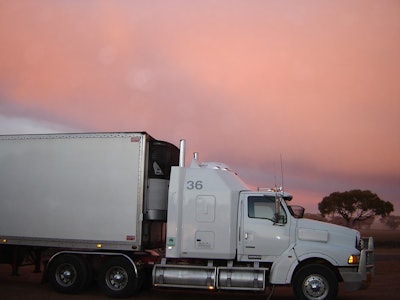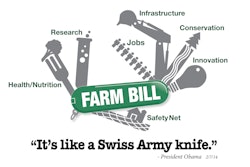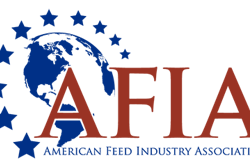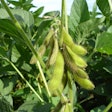
The U.S. Department of Transportation’s Federal Motor Carrier Safety Administration (FMCSA) on Nov. 19 released an interim final rule on the definition of agricultural commodity for use in determining which agricultural products are eligible to be hauled under the agricultural exemption to the hours-of-service (HOS) rules for commercial truck drivers.
Under the agricultural exemption, HOS regulations do not apply to the transportation of agricultural commodities by truck drivers operating completely within a 150 air-mile radius. Therefore, work and driving hours that occur within 150 air-miles of the source of the origin are not counted toward a driver’s daily driving limit of 11 hours or on-duty limit of 14 hours.
The agricultural exemption and the definition of agricultural commodities are important because agriculture heavily depends heavily on truck transportation and there are situations that require surges in trucking capacity. The agricultural exemption can provide the needed flexibility to handle the surges.
When FMCSA began the rulemaking process in 2019, the NGFA and 100 other national- and state-level agricultural associations submitted comments advising that the agricultural commodity definition encompass all products and processes that span agriculture. Below is a comparison of FMCSA’s previous and new definitions for agricultural commodity under its interim final rule:
- Previous Definition of Agricultural Commodity:“Agricultural commodity means any agricultural commodity, non-processed food, feed, fiber, or livestock (including livestock as defined in sec. 602 of the Emergency Livestock Feed Assistance Act of 1988 [7 U.S.C. 1471] and insects).”
- New Definition in the Interim Final Rule:“Agricultural commodity means any agricultural commodity, non-processed food, feed, fiber, or livestock as defined in this section. As used in this definition, the term “any agricultural commodity” means horticultural products at risk of perishing, or degrading in quality, during transport by commercial motor vehicle, including plants, sod, flowers, shrubs, ornamentals, seedlings, live trees, and Christmas trees.
“Livestock is defined as livestock in sec. 602 of the Emergency Livestock Feed Assistance Act of 1988 [7 U.S.C.1471], as amended, and insects, and all other living animals cultivated, grown, or raised for commercial purposes, including aquatic animals.
“Non-processed food means food commodities in a raw or natural state and not subjected to significant post-harvest changes to enhance shelf life, such as canning, jarring, freezing, or drying. The term “non-processed food” includes fresh fruits and vegetables, and cereal and oilseed crops which have been minimally processed by cleaning, cooling, trimming, cutting, chopping, shucking, bagging, or packaging to facilitate transport by commercial motor vehicle.”
The new definition of agricultural commodity takes effect 15 days after publication of the interim final rule in the Federal Register, which is expected to occur sometime during the first week of December. FMCSA is providing 30 days for the public to submit comments on the interim rule, and changes to the rule may be made based on the comments.
FMCSA’s interim rule definition creates uncertainty as to whether feed ingredients, such as soybean meal and dried distillers’ grains with solubles, would be covered under the agricultural exemption to the hours-of-service rules based – a major objective of NGFA. NGFA plans to submit comments urging FMCSA to specifically define feed as animal food, including animal food ingredients, to try to ensure feed ingredients are eligible to be transported under the agricultural exemption to HOS rules.


















